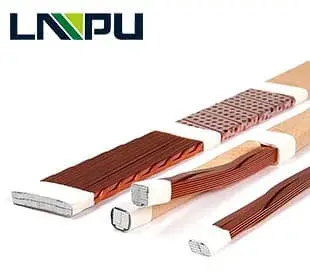
Continuous Transposed Cable (CTCS)
What is Continuous Transposed Cable (CTCS)?
Continuous Transposed Cable (CTCS)consists of a set of lacquered rectangular wires connected parallel to the ends. In this group, each share (lacquered rectangular line) continuously and repeatedly occupies every possible position in the entire cross section. The bundle is wrapped in oil-compatible pure cellulose paper. These conductors are made into a component, usually covered with a layer of insulating material. The number of conductors is usually an odd number (from 5 to 49), arranged side by side into two stacks. A special tool alternately pushes the upper left and lower right wires onto the corresponding adjacent stacks so that each wire occupies each possible position in a continuous transpose of cables within one cycle. The length of a continuous transposed cable for a complete cycle depends on the minimum diameter of the transformer winding, the number and size of the single strip.

CTC wire Specifications
| Transposition number | 5 – 80 (odd or even optional) |
| Maximum dimension | height 120 mm, width 26 mm (tolerance ± 0.05 mm) |
| Single conductor size | thickness a: 0.90 – 3.15 mm, width B: 2.50 – 13.00 mm (tolerance ± 0.01 mm) |
| The recommended width thickness ratio of a single conductor | 2.0 < B / a < 9.0 |
| The recommended coating thickness of enameled wire | 0.08-0.12mm |
| The thickness of adhesive layer | 0.03-0.05mm |
Advantages
1. The use of this material to manufacture transformers has non-negligible advantages, compared with other conductor materials, it can save more space, reduce the volume and reduce the cost, more importantly, reduce the flux loss and eddy current loss caused by magnetic loss, and improve the mechanical strength of the winding, shorten the winding time.
2.In contrast to solid conductors, transposition of basic conductors can create very flexible products capable of perfectly adapting the windings and significantly reducing electrical losses in the same part. Various advantages for transformers can be obtained by the number of units (strips) acting on the constituent CTCS.
3.At the same time, it reduces the manufacturing cost of transformer due to its small size. The combination of enamelled wire with small cross section replaces the combination of flat wire with large cross section, which can reduce the loss of discrete field.
4.Parallel to the dogan compared with single wire insulation, continuous transposed cable (CTC) is enameled single wire, and the film thickness paper insulation thickness is much thinner than in the past, but the pressure is several times of the insulation paper, plus public paper insulation insulation thickness is thin, so obviously reduced the volume of the winding, effectively improve the space utilization.
5.The transposition between the single wires makes the windings have higher mechanical strength. Thin film and insulation thickness, with better heat dissipation, so it has high thermal stability. It reduces the manual transposition, makes the winding process become simple, and shortens the winding processing time. For a transposition wire, winding one turn of a transposition wire is equivalent to winding many turns of a single flat parallel wire.
Application
Power Transformers: CTC is extensively used in the windings of large power transformers to improve efficiency and performance. It helps in managing the high currents and reduces losses.
Reactors: Used in reactors where high current handling and efficient heat dissipation are crucial.
Inductors: Suitable for inductors in high-power applications where minimizing losses and maintaining performance are essential.
Insulation paper
Continuous transposed cables (CTCS) can be insulated with a variety of tapes – from pure cellulosic kraft paper to heat stable paper or microcrepe paper – or with better performing insulators such as polyester and arylon for higher thermal ratings.
